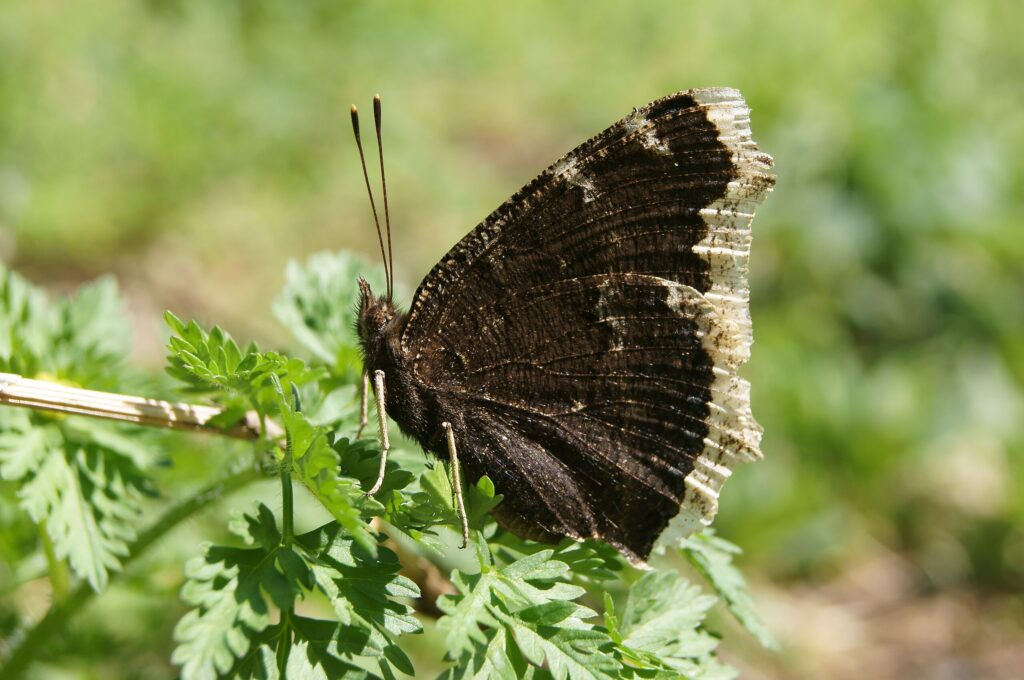Where do I spend most of my time? In my garden. I’m a huge gardening fan.
Taking care of plants, seeing them flourish, and witnessing the fruits of my labours fill me with satisfaction. However, let’s face it—it can be quite difficult.
One of the hardest things is dealing with pests. It might be difficult to determine which bugs are beneficial and which ones will undermine all of your hard work.
I just came across a photo on social media that perfectly captured this uncertainty. I was initially afraid of it. The image displayed a leaf that was covered in tiny, intricate black shapes.
Initially, it appeared as though the leaf had an odd, foreign design or perhaps was sick. I was one of the many people who wanted to know what it might be.

I did some investigation and discovered that the Nymphalis Antiopa butterfly is the source of these strange markings on the eggs.
Let me now explain you about this butterfly in case you are unaware of it.
The Mourning Cloak butterfly, Nymphalis Antiopa, is an intriguing insect with an unusual life cycle and intriguing characteristics.
Let’s now discuss the eggs. I spotted a close-up of these eggs on a leaf in the picture.
They appear to be distributed throughout the leaf like thin black lace. After you get over the shock, it’s actually pretty lovely.
Each tiny egg is a tiny geometric wonder that is perfectly formed, and they are laid in clusters. I immediately thought, “This could be really good or really bad for my garden,” when I first saw them.
The Nymphalis Antiopa butterfly is useful, which is good news.
Although the young, known as caterpillars, consume leaves, they typically have a preference for willows, elms, and poplars among other trees and shrubs.

Therefore, you should be good if your garden produces a lot of vegetables and flowers.
Since these butterflies also consume rotting fruit and aid in its breakdown, they can really be quite helpful.
It’s fascinating to watch these butterflies go through their entire cycle.
The caterpillars emerge from those oddly designed eggs and then become visible.
Their bodies are shaggy and spiky, and they are black with little white dots. They go through several phases known as instars, during which they get larger and lose their skin.
After they reach adulthood, the caterpillars look for a secure place to transform. They create a chrysalis, which resembles a tiny sleeping bag, and then they change.
This portion may need a few weeks to many months, contingent upon the season and weather.
When they do emerge, they are stunning Mourning Cloak butterflies, with dark, velvety wings dotted with blue and bordered in vivid yellow.
The behaviour of Mourning Cloak butterflies is one of their unique features. They sleep through the winter, in contrast to many others.
Usually they locate a warm spot under an old shed, under loose bark, or even in a pile of wood. They are among the first butterflies you see in the spring, frequently even before the flowers bloom.
Their early emergence is the reason for their name, Mourning Cloaks, as the dark wings against the scene of early spring resemble mourning garments.
As gardeners, we frequently worry that insects may damage our plants right away.

When we see caterpillars, we fear that they will devour everything. However, it’s critical to have a broader view and consider everything.
The Nymphalis Antiopa butterfly is a wonderful illustration of how nature achieves equilibrium. Although the caterpillars will consume some leaves, your garden won’t be destroyed by them.
Finding balance is key to gardening. It’s about fostering harmony between your pet animals and your favourite flora.
Before applying bug repellent, take a moment to investigate anything strange you see in your garden.
Like I discovered with the Nymphalis Antiopa butterfly eggs, you might discover something interesting.
It’s all just part of the fun, after all. What makes gardening so fulfilling is that there are always new challenges to learn and overcome with each passing season
If you would want to share some useful information, please SHARE this article with Family and Friends and let us know what you think in comments!
In actuality, you’re doing the environment a favour by providing a home for these butterflies.
What should you do, then, if you discover these caterpillars or eggs in your garden?
I would advise leaving them alone. Savour the ride as they develop and evolve.
You can carefully relocate the caterpillars to a tree or shrub where they will be content and less likely to consume your blooms if you’re extremely concerned about your plants.
